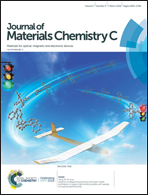Critical role of nanoinclusions in silver selenide nanocomposites as a promising room temperature thermoelectric material†
Abstract
The introduction of nanoinclusions within a host matrix allows reducing thermal conductivity, to introduce large amounts of charge carriers into the host matrix with a minimum impact on their mobility, and to increase the Seebeck coefficient through energy filtering. Nanoinclusions are particularly interesting to optimize the figure of merit of thermoelectric materials, ZT, which usually requires the use of relatively high charge carrier concentrations, n ∼ 1019 cm3. Herein, we introduce nonmetal (tellurium and selenium) and metal (copper) nanodomains into a silver selenide matrix through a bottom-up strategy using colloidal nanoparticles as building blocks. Upon assembly of the two materials, an electron exchange takes place at the matrix-nanoinclusion interphase. Depending on the nanoinclusion concentration and nature, we observed this exchange to modulate the free carrier concentration within the matrix or to result in a band bending that promotes electron filtering. We measure the free carrier concentration of the obtained nanocomposites and discuss here their contribution to ZT. Besides, a preliminary parameter optimization provides silver selenide nanocomposites with 5 mol% tellurium nanorods displaying ZT values up to 0.79 at room temperature. We attribute the improvement of the thermoelectric performance of Ag2Se with Te nanoinclusions to the electron filtering at interfaces that enhanced Seebeck coefficient without significantly compromising the electrical conductivity. On the other hand, similar loading of metal nanoinclusions (Cu) provided an opposite effect, as characterized by superior electrical conductivities and lower Seebeck coefficients.



 Please wait while we load your content...
Please wait while we load your content...